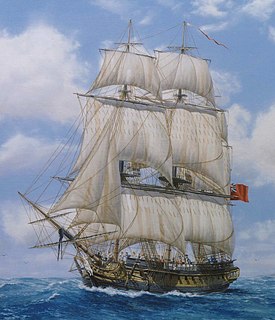Notes, citations, and references
Notes
- ↑ Petit Diable was a privateer that had been commissioned in Dunkirk in 1795 under the American captain William Ripner, with 44 men and 8 guns. [14]
- ↑ This may have been a 9-ton privateer commissioned in June 1796 in Boulogne under Jean-Pierre Sauvage-Clarté, with 34 men armed only with small arms. Her first cruise took place from June to August under Sauvage-Clarté; then from November to December she cruised under Jean-Augustin "Paquette" Huret. Her third cruise took place in December under Antoine Caudron, with a call to the port of Dieppe. She is said to have sailed again under Sauvage-Clarté in June 1797, and "probably" to have been captured by the British in June or July. This June 1797 cruise is inconsistent with Swallow's capture of Diable Volant in December 1796. [18]
- ↑ Adventure, clincher-built, of 65 tons (bm), had been built in 1795 at Torbay. She was on a voyage from London to Leghorn. [25]
- ↑ Revanche is likely a privateer from Calais, commissioned in February 1807. She made two cruises, first under an unknown captain from February to May 1807, then under François Fourmentin from December 1807 to January 1808. [31]
Citations
- ↑ Chatterton (1912), Chap. 8.
- ↑ Chatterton (1912), Appendix II.
- ↑ Tickell (1798), pp.646–7.
- ↑ Cowes Collector.
- ↑ Times London, England, 23 June 1791: 3. The Times Digital Archive. Web. 5 Nov. 2017.
- ↑ Letter of Marque, p.88 – accessed 25 July 2017.
- ↑ "No. 13825". The London Gazette . 24 October 1795. p. 1107.
- ↑ Steel (c.1801), p.46.
- ↑ "No. 13656". The London Gazette . 13 May 1794. p. 441.
- ↑ Musgrave (2011), Chap. 5.
- ↑ "No. 13792". The London Gazette . 30 June 1795. p. 697.
- ↑ "News in Brief." Times, London, England, 16 Sept. 1795: 3. The Times Digital Archive. Web. 5 Nov. 2017.
- ↑ "No. 13923". The London Gazette . 20 August 1796. p. 795.
- Demerliac (2004a), p. 214, n°1686.
- ↑ "No. 13926". The London Gazette . 30 August 1796. p. 822.
- ↑ Musgrave (2011), chap.5.
- ↑ Lloyd's List №2884.
- Demerliac (2004a), p.226 n°1847.
- ↑ Chatterton (1912), Appendix III.
- ↑ Naval Chronicle, Vol. 1, btwn. p.264 & 268.
- ↑ "No. 15453". The London Gazette . 13 February 1802. p. 158.
- ↑ "No. 15542". The London Gazette . 18 December 1802. pp. 1349–1350.
- ↑ Naval Chronicle, Vol. 3, p.512.
- ↑ London Chronicle (10–13 May 1800), Vol. 87, p.436.
- Register of shipping (1802), Seq. №A169.
- ↑ Martin (1876), pp.262–270.
- ↑ Newgate Calendar: website of Pascal Bonenfant – accessed 5 November 2017.
- ↑ Naval Chronicle Vol. 8, p.518.
- ↑ "No. 16121". The London Gazette . 20 February 1808. pp. 269–70.
- ↑ "No. 16215". The London Gazette . 3 January 1809. p. 24.
- Demerliac (2004b), p.237, n°1670.
- ↑ Lloyd's List №5135.
- 1 2 Marshall (1835), Vol. 4, Part 2, pp.91–2.
- ↑ Fisher (1821), p.9.
- ↑ Chatterton (1912), Chap.16.
- ↑ United service journal (1833), Part 1, p.102.
- ↑ Nautical Magazine and Naval Chronicle: A Journal of Papers on Subjects Connected with Maritime Affairs (1835), Vol. 4, p.317.
- ↑ Chatterton (1912), Appendix IV.
References
- Chatterton, E. Kemble (1912) King's Cutters and Smugglers, 1700–1855. (London:George Allen).
- Demerliac, Alain (2004a). La Marine de la Révolution: Nomenclature des Navires Français de 1792 A 1799 (in French). Éditions Ancre. ISBN 2-906381-24-1.
- Demerliac, Alain (2004b). La Marine du Consulat et du Premier Empire: Nomenclature des Navires Français de 1800 A 1815 (in French). Éditions Ancre. ISBN 2-903179-30-1.
 Marshall, John (1823–1835). "Index". Royal Naval Biography . London: Longman and company.
Marshall, John (1823–1835). "Index". Royal Naval Biography . London: Longman and company.- Fisher, Alexander (1821) A Journal of a Voyage of Discovery to the Arctic Regions: In His Majesty's Ships Hecla and Griper, in the Years 1819 & 1820. (Longman, Hurst, Rees, Orme, and Brown).
- Martin, Frederick (1876) The History of Lloyd's and of Marine Insurance in Great Britain: With an Appendix Containing Statistics Relating to Marine Insurance. (Macmillan and Company).
- Musgrave, Clifford (2011) Life in Brighton. (The History Press). ISBN 9780752496894
- Steel's Naval Remebrancer, from ... 1793 to ... 1800 ... containing an account of all the ships of the French, Dutch, Spanish, and British navies, lost, taken, or destroyed since the commencement of the present war, etc.
- Tickell, John (1798) The History of the Town and County of Kingston Upon Hull: From Its Foundation in the Reign of Edward the First to the Present Time, with a Description of Part of the Adjacent Country, Embellished with Engraved Views of Public Buildings, an Ancient and Modern Plan of the Town and Several Antiquities. (Thomas Lee & Company).





